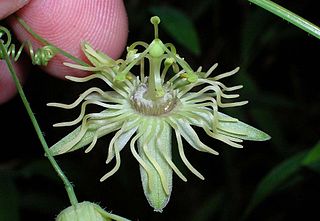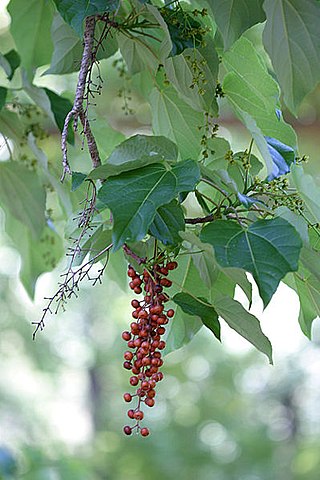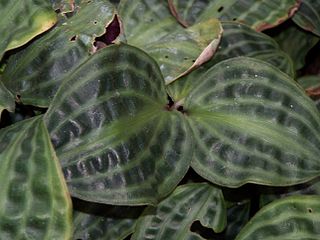
Conium is a genus of flowering plants in the family Apiaceae. As of December 2020, Plants of the World Online accepts six species.

Primula vulgaris, the common primrose, is a species of flowering plant in the family Primulaceae, native to western and southern Europe, northwest Africa, and parts of southwest Asia. The common name is primrose, or occasionally common primrose or English primrose to distinguish it from other Primula species also called primroses. None of these are closely related to the evening primroses.

Lathyrus japonicus, the sea pea, beach pea, circumpolar pea or sea vetchling, is a species of flowering plant in the legume family Fabaceae, native to temperate coastal areas of the Northern Hemisphere, and Argentina.

Horminum is a genus of flowering plants in the family Lamiaceae, comprising a single species, Horminum pyrenaicum. Common names include dragonmouth and Pyrenean dead-nettle.

Passiflora lutea, commonly known as yellow passionflower, is a flowering perennial vine in the family Passifloraceae, native to the central and eastern United States. The vine has three-lobed leaves and small, yellowish-green, fringed flowers that appear in the summer, followed by green fruit that turn almost black at maturity. It grows in moist to wet habitats.

Galeopsis tetrahit, the common hemp-nettle or brittlestem hempnettle, is a flowering plant in the family Lamiaceae, native to Europe and northwestern Asia.

Nepenthes surigaoensis is a tropical pitcher plant endemic to the Philippine island of Mindanao, where it grows at elevations of at least 800–1200 m above sea level.

Nepenthes lingulata is a tropical pitcher plant endemic to northern Sumatra. The species is characterised by the highly developed appendage present on the underside of the lid. The specific epithet lingulata is derived from the Latin word lingula, meaning "small tongue", and refers to this unique morphological feature.

Idesia is a genus of flowering plants in the family Salicaceae, comprising the single species Idesia polycarpa. It is native to eastern Asia in China, Japan, Korea, and Taiwan.

Nepenthes pitopangii is a tropical pitcher plant endemic to the Indonesian island of Sulawesi. Discovered in 2006, N. pitopangii was initially known from a single plant at a remote locality in Lore Lindu National Park. Efforts made in the following years to locate further populations on surrounding mountains proved unsuccessful. In March 2011, a new population of N. pitopangii consisting of around a dozen plants was discovered more than 100 km from the type locality. Nepenthes pitopangii appears to be closely related to N. glabrata, from which it differs most obviously in its upper pitcher morphology.

Geogenanthus is a genus of plants with 3 species in the family Commelinaceae. The genus is distributed from Colombia to Amazonian Peru and Brazil. Two of its species are occasionally found in the horticultural trade as house plants.

Streptanthus vernalis is a rare species of flowering plant in the mustard family known by the common name early jewelflower. It was first observed in the 1970s but not actually described to science until 2005. It is endemic to Lake County, California, where it is known from a single occurrence at Three Peaks near the Napa County line. It is apparently limited to serpentine outcrops in forested and chaparral habitat. Genetic analysis indicates that the species is distinct from other Streptanthus and is most closely related to Streptanthus morrisonii, which it resembles. It is a hairless annual herb producing an erect branching or unbranched stem 2 to 20 centimeters tall. The ephemeral basal leaves have thick, fleshy leaves which are green and unmottled on top and purple on the undersides. Leaves higher on the stem are linear to lance-shaped and lack petioles. Flowers occur at intervals along the upper stem. Each flower has an urn-shaped calyx of sepals which is solid green with no purple or yellowish tinge. The petals emerging from the tip are white without darker veining. The fruit is a flattened straight silique 3 to 5 centimeters long containing orange seeds.

Nepenthes leonardoi is a tropical pitcher plant known from a single locality in central Palawan, the Philippines. It is closely allied to several other Palawan endemics, including N. deaniana, N. gantungensis, and N. mira. The traps of this species reach at least 24 cm in height. Some specimens are noted for producing very dark, almost black, upper pitchers.

Geogenanthus poeppigii, commonly called the seersucker plant, is a flowering plant species in the family Commelinaceae. As currently circumscribed, the genus Geogenanthus includes two other species, G. ciliatus and G. rhizanthus. This species is named after 19th century German naturalist Eduard Friedrich Poeppig. Geogenanthus undatus is an outdated synonym for G. poeppigii.

Roscoea cautleyoides is a perennial herbaceous plant occurring in the Sichuan and Yunnan provinces of China. The scientific name is also spelt Roscoea cautleoides. Most members of the ginger family (Zingiberaceae), to which it belongs, are tropical, but R. cautleyoides, like other species of Roscoea, grows in much colder mountainous regions. It is sometimes grown as an ornamental plant in gardens.
Iris sikkimensis is a plant species in the genus Iris, it is also in the subgenus Iris and in the section Pseudoregelia. It is a rhizomatous perennial, from Sikkim. It has pale green or light green thin leaves, slender stem, 2 or 3 lilac or purple flowers, with a white beard with orange tips. It is thought to be a hybrid of Iris hookeriana and Iris kumaonensis.
Iris hellenica is a plant species in the genus Iris and the subgenus Iris. It is a rhizomatous perennial, from Saitas Mountain, in the Peloponnese Region of Greece. It has grey-green, sickle-shaped leaves, a tall slender stem, 2–3 white, lavender-blue, lilac or purple flowers and orange/purple beards. It was thought once to be a hybrid species of Iris germanica which also grows in the same area, before being separated into 2 species. It has only recently been published and is rarely cultivated as an ornamental plant in temperate regions.

Iris subbiflora is a plant species in the genus Iris, it is also in the subgenus Iris. It is a rhizomatous perennial, from Portugal and Spain in Europe. It has evergreen broad leaves, forming dense clumps, it has dwarf stems in late spring,, with 1 upright fragrant flower, in shades of purple, light red purple, grey-blue, blue-violet, or dark violet. It has a beard which is generally blue, purple, or violet, but can fade to white, dull yellow, or dark yellow. After being found in 1804, it was once a separate species until the late 70s, when it was reclassified as subspecies of Iris lutescens, and renamed Iris lutescens subsp. subbiflora. But in the 80s it was returned to an independent species but some authors and references still class the species as a synonym or subspecies. It is cultivated as an ornamental plant in temperate regions.

Iris atrofusca is a species in the genus Iris, where it is placed in the subgenus Iris and the section Oncocyclus. It is a rhizomatous perennial from the deserts of Israel and Jordan. The species has long falcate (sickle-shaped) or ensiform (sword-shaped) leaves, a long thick stem and large fragrant flowers that come in shades of purple brown, reddish-black, black-brown, dark brown, dark lilac or dark purple. The flowers also have a black or brownish-black signal patch and a thick beard that is brown-black, light brown or yellow tipped with brown. It is rarely cultivated as an ornamental plant in temperate regions.

Iris bismarckiana, the Nazareth iris, is a species in the genus Iris, it is also in the subgenus Iris and in the section Oncocyclus. It is a rhizomatous perennial, from the mountainsides of Israel, Lebanon, Jordan and Syria. It has stoloniferous, spreading rhizomes, long, sword shaped, bright green leaves, long slender stem and 1 flower in Spring. The large flower is pale yellow, creamy-white, or white background. Which is covered with reddish-brown, maroon brown, purple-brown, purple, blue-purple, or blue veins, markings or spots. It has a dark signal patch and dark purple to black beard. It is rarely cultivated as an ornamental plant in temperate regions, as it needs very dry conditions during the summer.


















